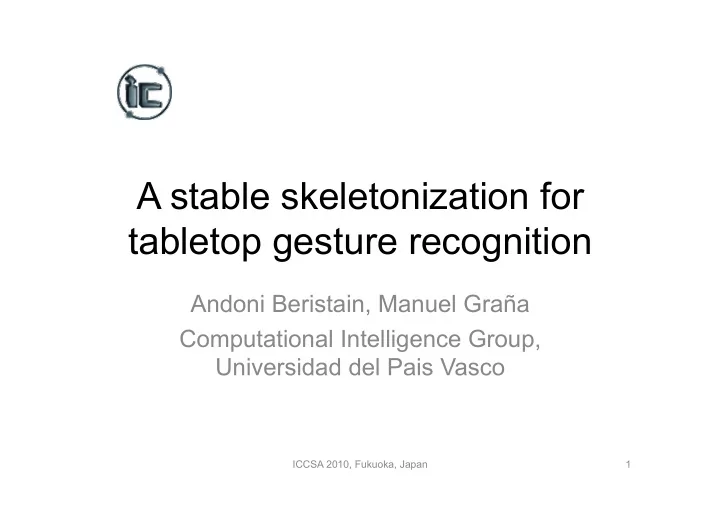

A stable skeletonization for tabletop gesture recognition Andoni Beristain, Manuel Graña Computational Intelligence Group, Universidad del Pais Vasco ICCSA 2010, Fukuoka, Japan 1
Contents • Introduction • Skeletonization algorithm • Results – Real time implementation – Classification of gestures for tabletop interaction ICCSA 2010, Fukuoka, Japan 2
Introduction • Aim: gestual interaction with tabletop systems – Naturalness of the interaction – Basic gestures: grabbing, pointing, passing a page. • Approach: – Skeleton as a key feature extraction – Classification based on skeleton features ICCSA 2010, Fukuoka, Japan 3
Introduccion • Skeletonization procedure – Voronoi skeleton – Two Pruning steps • Removing edges crossing the object boundary • Discrete Curve Evolution based approach ICCSA 2010, Fukuoka, Japan 4
Skeletonization algorithm • Starting from the boundary of the object • Four steps – Shape boundary subsampling – Voronoi Tessellation computation: • the Voronoi edges inside the form are the skeleton branches – Discrete Curve Evolution computation (DCE) on the boundary – Pruning ICCSA 2010, Fukuoka, Japan 5
• Voronoi tesselation & skeleton ICCSA 2010, Fukuoka, Japan 6
• Voronoi skeleton ICCSA 2010, Fukuoka, Japan 7
Skeletonization algorithm • Discrete Curve Evolution – The contour is iteratively simplified removing the points with the lowest saliency curvature coefficient – The stopping criterion is the minimal number of points in the contour – Remaining vertices are joined by lines to form the simplified contour ICCSA 2010, Fukuoka, Japan 8
• Result of DCE for the hand shape ICCSA 2010, Fukuoka, Japan 9
• First pruning: removing Voronoi edges crossing the boundary ICCSA 2010, Fukuoka, Japan 10
• Pruning speedup – Only the two extreme points of the Voronoi segment need to be tested to determine if the whole segment belongs to the object ICCSA 2010, Fukuoka, Japan 11
• Second pruning step – Compute the convex hull on the DCE contour – Voronoi edges with generative points belonging to the same convex hull segment are removed ICCSA 2010, Fukuoka, Japan 12
• Segments removed in the second pruning step ICCSA 2010, Fukuoka, Japan 13
ICCSA 2010, Fukuoka, Japan 14
Results • Real time implementation • http://www.ehu.es/ccwintco/index.php/2009-10-24-video-skeleton ICCSA 2010, Fukuoka, Japan 15
Results • Tabletop gesture interaction database • Generated in-house • Made available to the public ICCSA 2010, Fukuoka, Japan 16
ICCSA 2010, Fukuoka, Japan 17
• Distance between skeletons computed by a greedy matching algorithm – Nodes are extreme vertices of the Voronoi edges – Associate nodes in pairs following the order from the closest to the image window boundary to its center ICCSA 2010, Fukuoka, Japan 18
• Patter recognition: – K-NN algorithms based on the greedy graph distance • Validation over the tabletop gesture database – Perform ten-fold cross validation – Compare with the Bai skeletonization algorithm ICCSA 2010, Fukuoka, Japan 19
ICCSA 2010, Fukuoka, Japan 20
ICCSA 2010, Fukuoka, Japan 21
Conclusions • Our algorithm (Beris) outperforms the Bai algorithm recognition in most of cases. • Higher values of the α parameter in the Node Distance produce better results. – This results mean that the geometrical position of nodes is more important for matching than the DT value. ICCSA 2010, Fukuoka, Japan 22
• Against our expectations, less DCE pruning does not produce better recognition results. – it seems that higher DCE pruning parameter values add clutter to the representation, instead of enriching it. • The confusion between the grab and page turn classes can be explained as follows: • We are classifying all the instantaneous poses of a gesture as this gesture. • Some of the intermediate poses of these classes are nearly indistigu- ishable. • The classification of these poses is at the surce of confussion. ICCSA 2010, Fukuoka, Japan 23
Recommend
More recommend